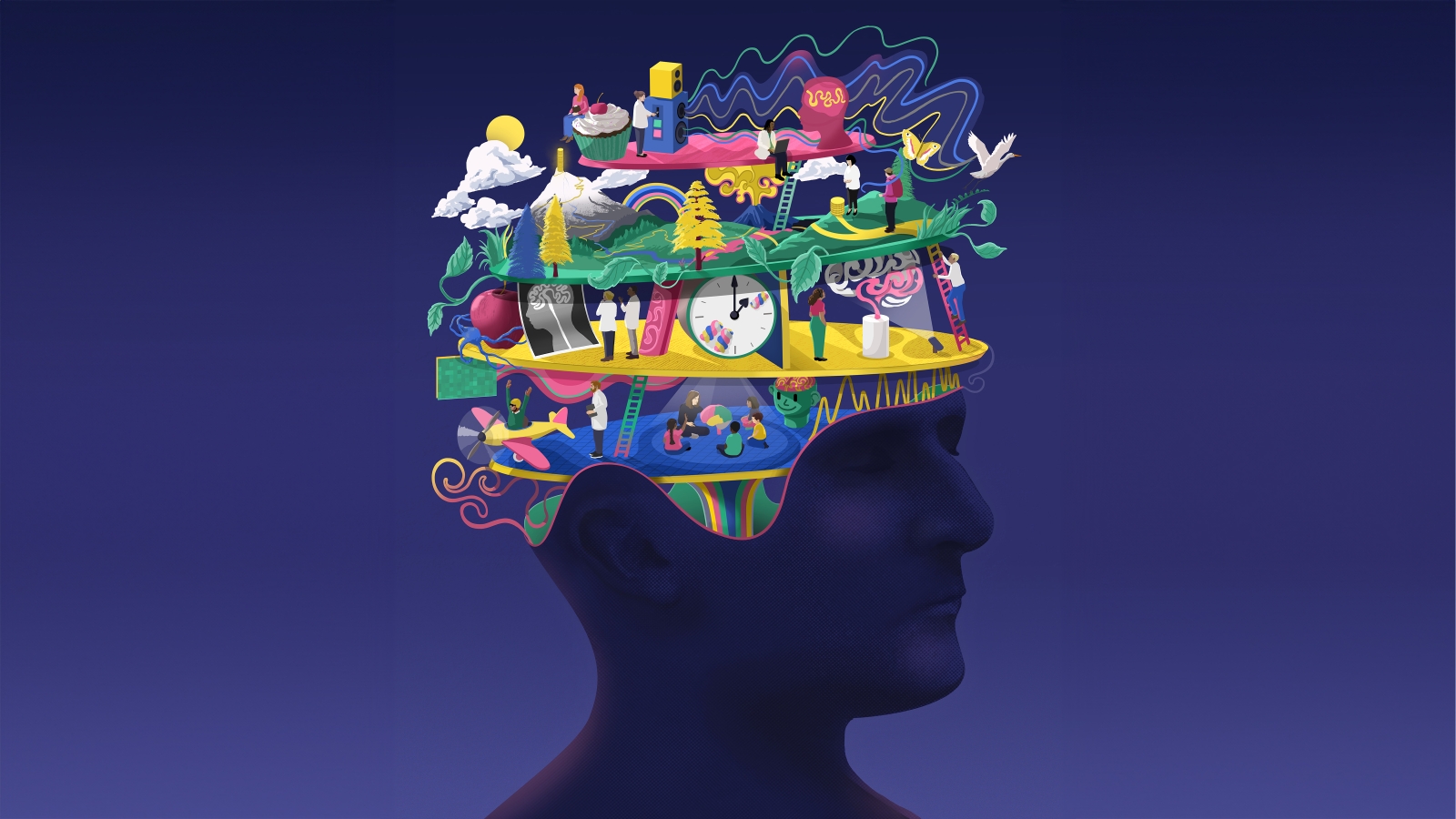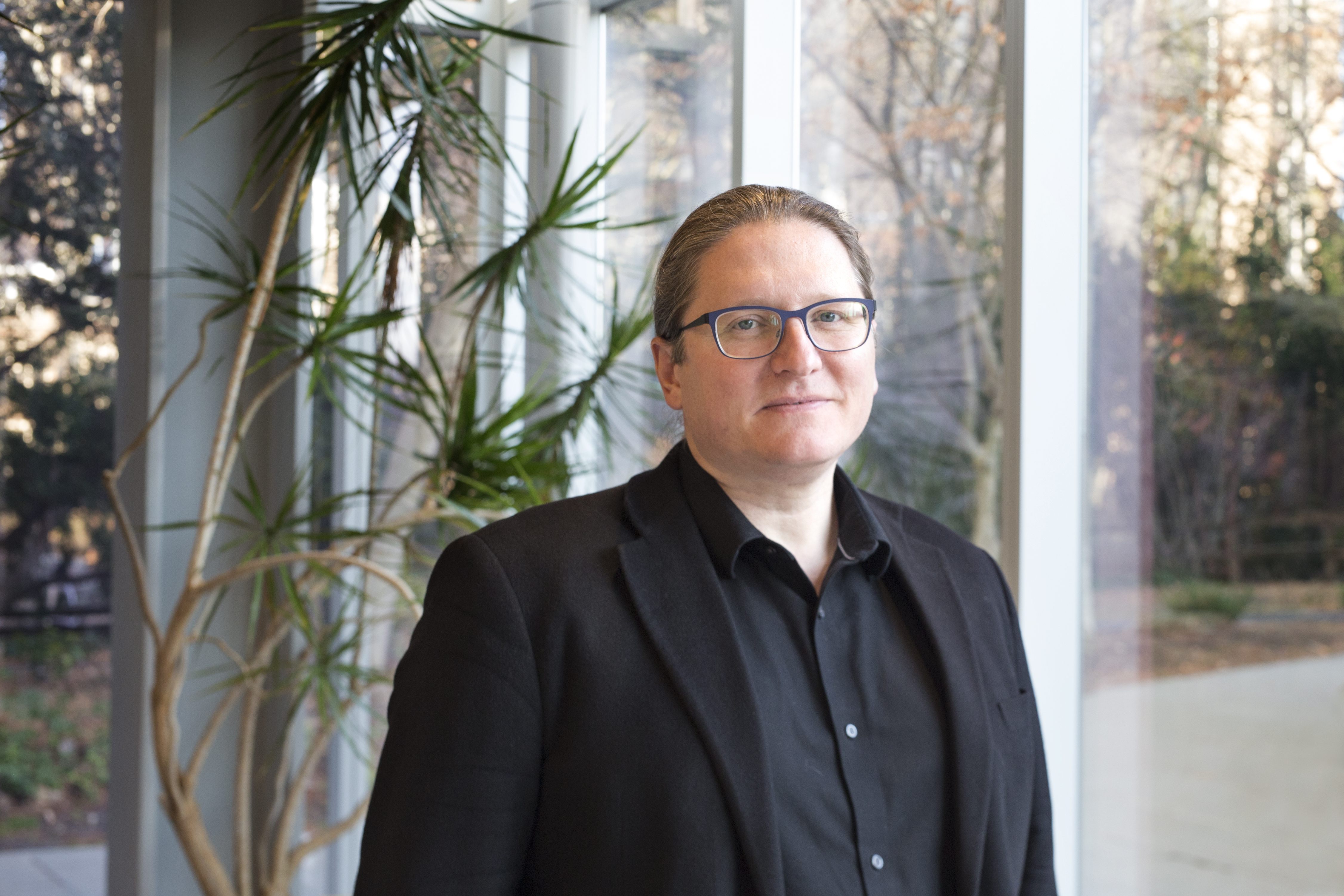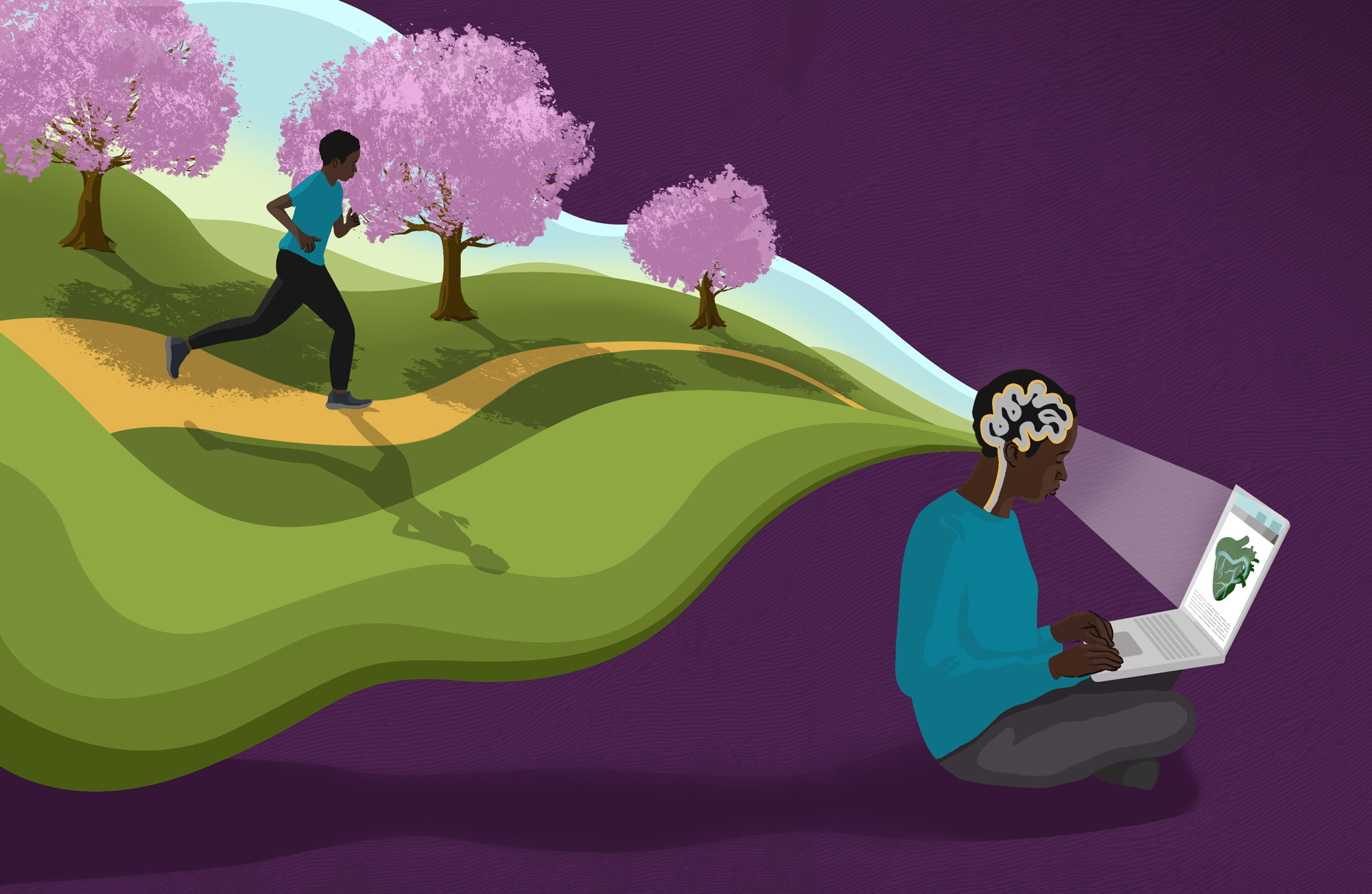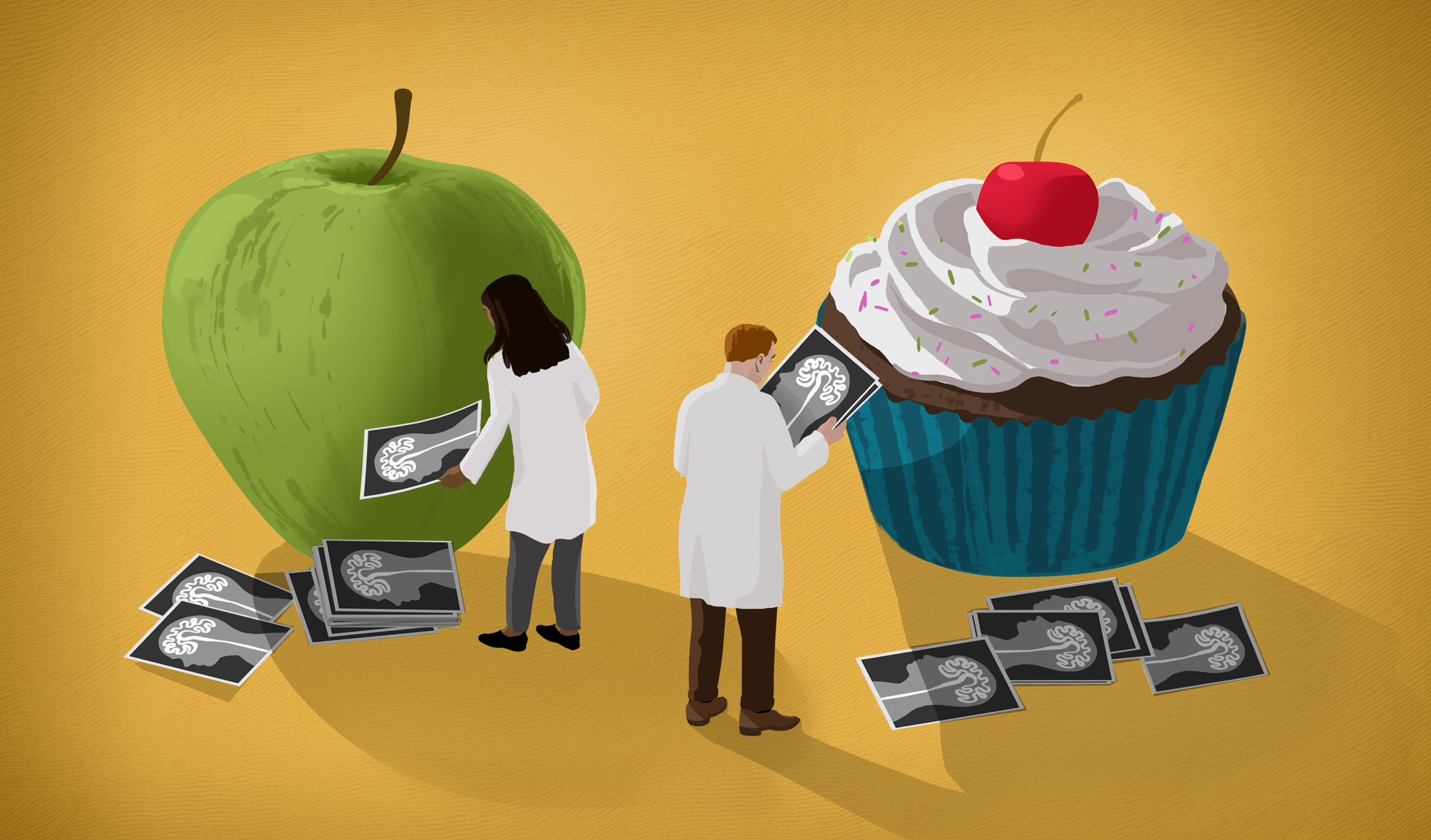Whether Forecasting
Joseph Kable, Baird Term Professor of Psychology and Director of MindCORE, studies the brain activity that drives decision-making.

Research has shown that the average adult makes approximately 2,000 decisions every waking hour—and that many of them are bad, from minor missteps like skipping breakfast to serious offenses like robbing a bank.
“Most of our societal problems come from poor decisions that we make,” says Joseph Kable, GR’04, Baird Term Professor of Psychology and Director of MindCORE, Penn's hub for the integrative study of the mind. “For proof that we are our own worst enemies, just turn on the news.”
Consider the COVID-19 pandemic, Kable suggests. Within a year of its onset, a vaccine was available. Viral spread persists, however, largely because some people refuse to wear masks or to physically distance themselves from others. “We nailed what you might assume is the hard part—the immunology problem,” he says. “What trips us up is human behavior.”
Kable investigates what brain structure and function reveal about why people make decisions, good or bad. This area of study was just emerging as he pursued his Ph.D. in neuroscience at Penn in the early aughts and has grown rapidly over the past decade and a half, with researchers uncovering surprising links between neural activity and personal conduct. Exploring these connections, Kable says, could have implications for the health, safety, and well-being of people everywhere.
“If we can understand why people make the decisions they do,” he explains, “we might be able to help them to make better ones—to change their behavior and make the world a better place.”
Mental Pictures
Kable’s work sits at what he calls “the crux of neuroeconomics,” a discipline that integrates economics, psychology, and neuroscience to glean a better understanding of economic decision-making. Modern economic theory posits what decision people should make in a given situation to meet certain goals, but it doesn’t address their actual thought processes—what’s going on inside their minds. That’s where psychology comes in.
“Knowing both of those things—the best way to solve a decision problem as well as the things someone is or isn’t considering while making a decision—tells us a little bit about what to look for in the brain to understand the underlying neural process,” Kable says. “Then that neuroscience feeds back into the other fields, because knowing what the brain does and doesn’t do limits your theorizing at the economics and psychology levels.”
I started out studying neurochemicals and things at the cellular level. Then I took a step back and thought about how this thing I was studying—the brain—is responsible for consciousness, art, music, religion.
Luckily for neuroeconomists, observing brain activity in real time is easy with functional magnetic resonance imaging, or fMRI—a noninvasive procedure performed with the same kind of MRI machine physicians use to diagnose many injuries and diseases. Researchers like Kable use the equipment in a slightly different way so that images show blood flow in the brain, indicating exactly where activity is happening while a person performs some sort of mental task—like making a decision.
“I started out studying neurochemicals and things at the cellular level. Then I took a step back and thought about how this thing I was studying—the brain—is responsible for consciousness, art, music, religion. People are the ones who engage in those things, so why not study the way the brain works in actual people?” says Kable. “Studying decision-making was a way for me to transition into human neuroscience, focusing on the question ‘Why do people do what they do?’”
In his experiments, Kable collects functional brain images as participants evaluate specific tradeoffs, often involving money. To gauge someone’s capacity to delay gratification, he might ask whether they’d prefer to receive $20 immediately or $40 in three months. Or, he might add a social component, telling them they must share $20 with another person and asking whether they would split the total evenly, or give themselves a larger amount.
Through his own studies, along with a comprehensive meta-analysis of hundreds of other neuroimaging studies—involving financial rewards as well as things like showing pictures of attractive women to heterosexual men, offering drugs to drug users, and playing a participant’s favorite music—he and his team have identified structural and functional elements of the brain that relate to subjective value in two key areas: the ventromedial prefrontal cortex and ventral striatum.
“When you measure responses in these regions, there is greater activity when you receive something that is rewarding or pleasurable compared to something that is less rewarding or less pleasurable. And this is a continuous signal—the better the option we present, the more activity we see,” he says. “I like to say these are the areas of the brain that help you recognize the rewarding aspects of sex, drugs, and rock and roll.”
Kable recalls that when he started doing these experiments nearly 15 years ago, many in academia doubted that visible brain activity would correlate to people’s actions. Today, he is confident that the data he captures is predictive of people’s behavior outside of the lab.
“Anecdotally, I always go back to the very first study I did on the neural basis of impulsivity. The first time I was measuring decision-making [using fMRI], the most impulsive person wanted his money right now,” Kable says. “It was quite a bit of money, and a week later, he sent me very cool pictures of the skydiving trip he spent it all on. That’s a pretty impulsive behavior—so, yes, I believe that was a sign our results would translate.”
This is not mind reading in the sense that we can say with 100 percent accuracy what someone will do next in their lives ... but we can predict, at above-chance levels, if someone will choose a Butterfinger or a Baby Ruth from a candy machine.
According to Kable, his and other researchers’ findings have proved so consistent that by looking at markers in someone’s brain, they can predict that person’s “choice tendencies”—whether they are generally more impulsive and present-oriented or more patient and future-oriented. And by measuring functional activity, they can predict what a person will choose when presented with specific options. Moreover, they have been able to build a “map” of brain activity that works universally across people, without the need for individual tailoring.
“This is not mind reading in the sense that we can say with 100 percent accuracy what someone will do next in their lives,” Kable says, “but we can predict, at above-chance levels, if someone will choose a Butterfinger or a Baby Ruth from a candy machine.”
Crossing Minds
Practical applications for neuroeconomics extend far beyond predicting someone’s preferred brand of candy bar. Researchers across Penn have harnessed knowledge about brain activity to help change people’s behavior, often using findings from Kable’s lab as a jumping-off point. Among them is Emily Falk, Professor of Communication, Psychology, and Marketing at the Annenberg School for Communication, who studies the neural signatures of message effectiveness—particularly when messages pertain to health.
In her own neuroimaging studies, Falk focuses on the brain regions Kable and his lab previously identified as involved in weighing subjective value. For example, she and her colleagues once used fMRI to measure activity in those areas of the brains of approximately 40 young adults in Philadelphia as they read various health news headlines. They subsequently used that data to predict how likely those articles were to be shared online around the world; the ones that sparked the most activity in her participants’ brains proved the most likely to go viral.
“Since Joe’s group did that fantastic meta-analysis of studies on valuation, we know where to look for things that happen in people’s brains when they are exposed to different kinds of messaging,” says Falk, noting that this kind of knowledge may be able to help public health professionals predict what kinds of messages audiences will best respond to and inform campaigns that will help people become healthier.
Results like Falk’s suggest promise for using neuroscience to improve interventions, Kable says. “We are past the ‘Can we do this at all?’ phase and are now asking, ‘Why does it work, and under what conditions? What are the nitty-gritty details?’ There is a lot more to uncover, but seeing the basic phenomenon in action is, like, whoa.”
All Together Now
Falk is one of dozens of faculty members University-wide affiliated with MindCORE, the organization for which Kable serves as director. Established in 2018, MindCORE (Mind Center for Outreach, Research, and Education) brings together mind and brain researchers across Penn to collaborate on scientific, teaching, and outreach programs.
“Understanding why people do the things they do is a hard problem, and we need to bring together all the tools we have to bear on it. That requires social scientists, psychologists, biologists, computer scientists, people from AI and linguistics, and so on to combat our tendency to stay in silos,” Kable says. “We all have our little areas of focus, but to understand something as complex as human behavior, we need to bring these different disciplines together and get them talking to each other.”
MindCORE fosters collaboration between different departments and centers both within Penn Arts & Sciences and with the Perelman School of Medicine, Wharton, Engineering, and the Annenberg School for Communication, supporting resulting initiatives with seed funding, technology, and programming. The Center also supports interdisciplinary undergraduate and graduate programs to educate the next generation of mind and brain researchers, including through the Lila R. Gleitman Undergraduate Summer Fellowship Program—a rigorous 10 weeks during which undergraduate students design and conduct experiments alongside professors and graduate students.
Recently, the National Science Foundation committed to funding the participation of students from outside Penn, primarily from backgrounds underrepresented in the sciences, in the Gleitman program.
“We know that many students of the mind at other institutions do not have access to the facilities and laboratories that are so strong and varied on Penn’s campus. Increasing involvement of students from a broader array of institutions could contribute in important ways to enhancing diversity in the discipline,” says Sharon Thompson-Schill, Christopher H. Browne Distinguished Professor of Psychology and MindCORE’s Founding Director. “This is a concrete way for Penn to address important issues of racial equity, inclusion, and diversity beyond the impact we can have with current students.”
There’s also the MindCORE Fellows program, which brings postdocs to work on cutting-edge research with Penn faculty as a springboard to their own independence.
“One of our first Fellows, Julia Leonard, will move into a faculty position in Psychology at Yale this summer—a huge success!” Kable notes.
Off campus, MindCORE reaches out to the community through lectures, partnerships with schools and museums, and interactive science initiatives. The coronavirus pandemic has temporarily halted these activities, but Kable hopes they can resume as soon as group gatherings become safe—especially the Center’s “Pop-Up Labs,” short-term research sites MindCORE faculty set up at festivals and in libraries and museums to engage the general public in the scientific process.
How does collective behavior arise from the principles we’ve established regarding how individual minds and brains work? How do phenomena at the collective level impinge on and shape cognition and brain activity in individuals? These are the questions we’re looking to explore.
When COVID concerns diminish, Kable also aims to spearhead a cluster hire in the “interconnected mind,” drawing faculty involved in a mind and brain research frontier: the relationship between the individual and the collective.
“How does collective behavior arise from the principles we’ve established regarding how individual minds and brains work? How do phenomena at the collective level impinge on and shape cognition and brain activity in individuals? These are the questions we’re looking to explore,” he says.
Another venture on the MindCORE horizon: a new functional brain imaging center. Planned for the Pennovation Works campus at the intersection of 34th Street and Grays Ferry Avenue, the facility will support basic research while allowing students to get hands-on experience with brain imaging technology—a rare opportunity for undergraduate students.
“When I was in college, neuroeconomics didn’t even exist as a field. The mind and brain research and education opportunities for undergrads and grad students have changed so much, so quickly—and it’s exciting to think about how MindCORE can offer them even more going forward,” Kable says. “For me, as director, the best part of MindCORE is thinking about all the new things we can do and create that haven’t existed yet at Penn to make our collective work on the mind and brain better.”







